Index to Trees & Shrubs in the Order Gentianales
Family: Apocynaceae (Oleander, Frangipani, Periwinkle, Milkweed and Asclepiad Family)
640.1 Carissa bispinosa Forest Num-num https://africawild-forum.com/viewtopic. ... 25#p243125
648. Pachypodium lealii Bottle Tree https://africawild-forum.com/viewtopic. ... 71#p171471
644. Tabernaemontana elegans Toad Tree https://africawild-forum.com/viewtopic. ... 77#p171477
Adenium oleifolium Stapf
Family: Loganiaceae/Strychnaceae (Monkey Orange Family)
626. Strychnos madagascariensis Black Monkey-orange https://africawild-forum.com/viewtopic. ... 80#p171480
629. Strychnos spinosa Spiny Monkey-orange, Green Monkey-orange https://africawild-forum.com/viewtopic. ... 86#p171486
Family: Rubiaceae (Coffee Family)
701. Alberta magna Natal Flame Bush https://africawild-forum.com/viewtopic. ... 87#p171487
684. Breonadia salicina Matumi https://africawild-forum.com/viewtopic. ... 17#p508317
691. Gardenia volkensii Bushveld Gardenia, Transvaal Gardenia https://africawild-forum.com/viewtopic. ... 88#p171488
700.2 Heinsia crinita parviflora Jasmine-Gardenia, Small False Gardenia https://africawild-forum.com/viewtopic. ... 65#p175265
694. Rothmannia fischeri fischeri Woodland Rothmannia https://africawild-forum.com/viewtopic. ... 89#p193589
694.1. Rothmannia fischeri moramballae Sand Rothmannia https://africawild-forum.com/viewtopic. ... 89#p171489
Africa Wild Tree & Shrub Book - Order Gentianales
Moderator: Klipspringer
Re: Africa Wild Tree & Shrub Book - Order Gentianales
648. Bottle Tree, Winter Bottelboom Pachypodium lealii (Bottleboom)
Order: Gentianales. Family: Apocynaceae

Kaokoveld, Namibia
Description
Thickset spiny succulent shrub or small tree up to 6 m high, with watery latex: trunk often somewhat bottle-shaped with a few upright branches. Like other pachypodiums, this succulent stem of the plant acts as a water store that enables it to tolerate the hot, dry environments in which it grows.
The branches are few and covered by slender thorns up to 30 cm long. The leaves are in spiral clusters towards the tips. Leaves are oblong and are covered with short hairs on both surfaces. At flowering time in spring, the leaves drop off, and long, pointed buds at the ends of the leafless branches open into attractive, sweet-smelling, white flowers, flushed with purple on the undersides.
Its sap is highly toxic.
Distribution
The Bottle Tree is an endemic species of Namibia and southern Angola. It is especially common in the Etendeka plateau of NE Namibia, where it can be seen growing in the basalt slopes.
Habitat
It prefers the semi-desert areas and dry bushvelds, usually along rocky hillsides.
Links: PlantZAfrica; ARKive
Order: Gentianales. Family: Apocynaceae

Kaokoveld, Namibia
Description
Thickset spiny succulent shrub or small tree up to 6 m high, with watery latex: trunk often somewhat bottle-shaped with a few upright branches. Like other pachypodiums, this succulent stem of the plant acts as a water store that enables it to tolerate the hot, dry environments in which it grows.
The branches are few and covered by slender thorns up to 30 cm long. The leaves are in spiral clusters towards the tips. Leaves are oblong and are covered with short hairs on both surfaces. At flowering time in spring, the leaves drop off, and long, pointed buds at the ends of the leafless branches open into attractive, sweet-smelling, white flowers, flushed with purple on the undersides.
Its sap is highly toxic.
Distribution
The Bottle Tree is an endemic species of Namibia and southern Angola. It is especially common in the Etendeka plateau of NE Namibia, where it can be seen growing in the basalt slopes.
Habitat
It prefers the semi-desert areas and dry bushvelds, usually along rocky hillsides.
Links: PlantZAfrica; ARKive
Re: Africa Wild Tree & Shrub Book - Order Gentianales
644. Toad Tree Tabernaemontana elegans
Order: Gentianales. Family: Apocynaceae


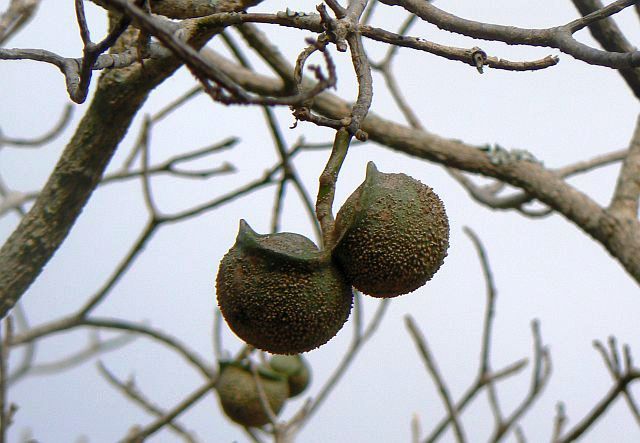

Tembe Elephant Park, KwaZulu-Natal
Description
Tabernaemontana elegans is a small deciduous bushveld tree between 3 and 10 m in height. All parts with milky latex.
The trunk is 50–300 mm thick with a corky, pale brown bark with longitudinal fissures. Leaves opposite, elliptic, leathery, glossy dark green, usually hairless on both surfaces with 12-23 lateral veins on each side of the midrib, straight but curving up near the margin.
The flowers are white in lax corymbs, and sweetly scented, attracting various insects. It flowers from September to March.
The edible fruits, are also paired, but covered in light brown warts resembling a toad's skin, hence the common name. Fruits in spreading pairs of obliquely ovoid, beaked pods, each up to 8 cm, glaucous or green. They occur from February to August.
The yellow pulp from the fruit is eaten by people, monkeys, baboons, rhinoceroses, hornbills and white-eared barbets.
Distribution
The Toad Tree is indigenous to tropical east Africa through to South Africa. In southern Africa the toad tree occurs from northern Natal and southern Mozambique through Swaziland and the eastern Transvaal into southern and eastern Zimbabwe. Provincial distribution in South Africa: KwaZulu-Natal, Limpopo, Mpumalanga.
Habitat
It is most commonly encountered along riverbanks, in coastal forest and savanna woodlands.
Order: Gentianales. Family: Apocynaceae




Tembe Elephant Park, KwaZulu-Natal
Description
Tabernaemontana elegans is a small deciduous bushveld tree between 3 and 10 m in height. All parts with milky latex.
The trunk is 50–300 mm thick with a corky, pale brown bark with longitudinal fissures. Leaves opposite, elliptic, leathery, glossy dark green, usually hairless on both surfaces with 12-23 lateral veins on each side of the midrib, straight but curving up near the margin.
The flowers are white in lax corymbs, and sweetly scented, attracting various insects. It flowers from September to March.
The edible fruits, are also paired, but covered in light brown warts resembling a toad's skin, hence the common name. Fruits in spreading pairs of obliquely ovoid, beaked pods, each up to 8 cm, glaucous or green. They occur from February to August.
The yellow pulp from the fruit is eaten by people, monkeys, baboons, rhinoceroses, hornbills and white-eared barbets.
Distribution
The Toad Tree is indigenous to tropical east Africa through to South Africa. In southern Africa the toad tree occurs from northern Natal and southern Mozambique through Swaziland and the eastern Transvaal into southern and eastern Zimbabwe. Provincial distribution in South Africa: KwaZulu-Natal, Limpopo, Mpumalanga.
Habitat
It is most commonly encountered along riverbanks, in coastal forest and savanna woodlands.
Re: Africa Wild Tree & Shrub Book - Order Gentianales
626. Black Monkey-orange Strychnos madagascariensis (Swartklapper, Botterklapper)
Order Gentianales. Family Loganiaceae
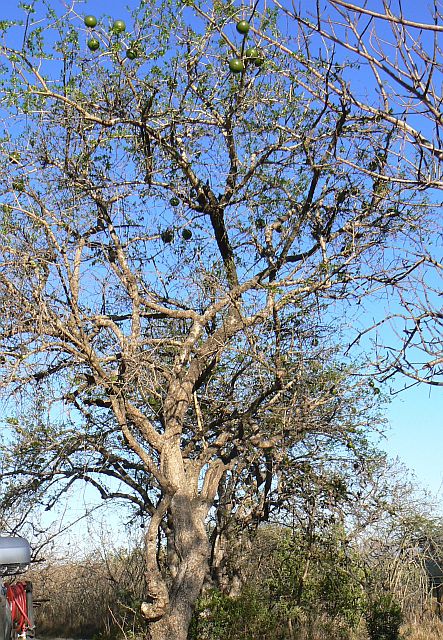

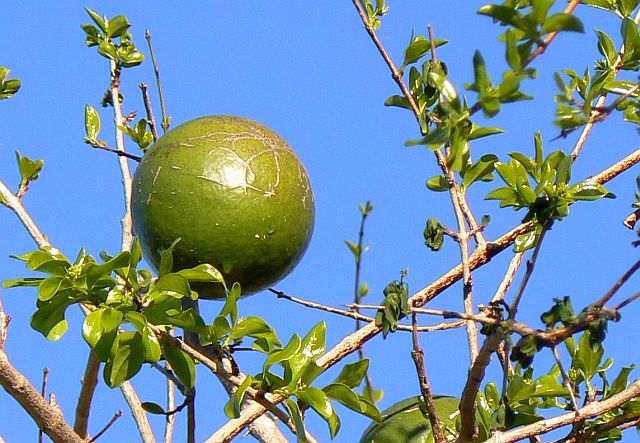
iMfolozi Game Reserve, KwaZulu-Natal © Toko

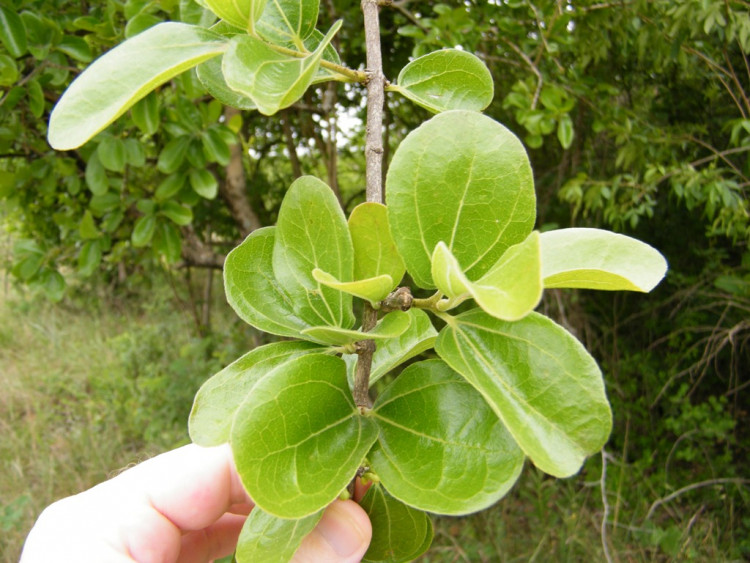

Nelspruit, Mpumalanga, Dec 2020 © Richprins
Description
Strychnos madagascariensis is 5-8 m tall and is heavily branched. Spineless. A very variable tree, it may be single-stemmed with a grooved and dented stem, or (more often) multi-stemmed, branching low-down. Many thin branchlets and twigs come off the main branches irregularly, giving it a thick, matted appearance. Side branches tend to emerge at right angles. The bark is pale grey with white patches which darken with age. Black Monkey-orange fruit is distinctive in winter, often growing on knobbly branches with lichen.
Broadly elliptic simple leaves are velvety, blue-green above and paler below, hairy and leathery and are oppositely arranged with an entire margin.They have a round tip and wedge-shaped base, and the margins are smooth. 3 - 5 veins radiate from the base, with two secondary veins that run parallel to the margin (Leaf: 20 - 90 x 10 - 60 mm). Leaves are not attached by an obvious leaf stalk and are clustered on the ends of short thick twigs.
Small, inconspicuous, greenish-yellow, trumpet-shaped flowers grow in small clusters at the base of the leaves on the old wood. Flowers tend to appear only after good rains (Nov - Dec) (8 - 10 mm diam.).
The smooth, hard fruit is large and green for most of the year, ripening to yellow. The fruit may take a long time to ripen and may still be present into the next flowering season. Large seeds are tightly packed inside the shell, and each seed is covered by yellow pulp (Mar - Aug) (70 - 120 mm).
Distribution
It is found in Botswana, Limpopo, North-West, Mpumulanga, eSwatini and KwaZulu-Natal.
Habitat
Black Monkey-orange grows singly on well-drained soils in rocky areas and in open bushveld, in riverine fringes and coastal bush, and grassland. It is easily noticed in the Sand Forest at the coast and is also common in the woodland and thornveld of the bushveld savanna.where there is little risk of fire.
Links:
https://treesa.org/strychnos-madagascariensis/
Rina Grant, Val Thomas: Sappi Tree Spotting: Bushveld, Including Pilanesberg and Magaliesberg; Ernst Schmidt, Mervyn Lotter, Warren McCleland: Trees and Shrubs of Mpumalanga and Kruger National Park
Order Gentianales. Family Loganiaceae



iMfolozi Game Reserve, KwaZulu-Natal © Toko
Nelspruit, Mpumalanga, Dec 2020 © Richprins
Description
Strychnos madagascariensis is 5-8 m tall and is heavily branched. Spineless. A very variable tree, it may be single-stemmed with a grooved and dented stem, or (more often) multi-stemmed, branching low-down. Many thin branchlets and twigs come off the main branches irregularly, giving it a thick, matted appearance. Side branches tend to emerge at right angles. The bark is pale grey with white patches which darken with age. Black Monkey-orange fruit is distinctive in winter, often growing on knobbly branches with lichen.
Broadly elliptic simple leaves are velvety, blue-green above and paler below, hairy and leathery and are oppositely arranged with an entire margin.They have a round tip and wedge-shaped base, and the margins are smooth. 3 - 5 veins radiate from the base, with two secondary veins that run parallel to the margin (Leaf: 20 - 90 x 10 - 60 mm). Leaves are not attached by an obvious leaf stalk and are clustered on the ends of short thick twigs.
Small, inconspicuous, greenish-yellow, trumpet-shaped flowers grow in small clusters at the base of the leaves on the old wood. Flowers tend to appear only after good rains (Nov - Dec) (8 - 10 mm diam.).
The smooth, hard fruit is large and green for most of the year, ripening to yellow. The fruit may take a long time to ripen and may still be present into the next flowering season. Large seeds are tightly packed inside the shell, and each seed is covered by yellow pulp (Mar - Aug) (70 - 120 mm).
Distribution
It is found in Botswana, Limpopo, North-West, Mpumulanga, eSwatini and KwaZulu-Natal.
Habitat
Black Monkey-orange grows singly on well-drained soils in rocky areas and in open bushveld, in riverine fringes and coastal bush, and grassland. It is easily noticed in the Sand Forest at the coast and is also common in the woodland and thornveld of the bushveld savanna.where there is little risk of fire.
Links:
https://treesa.org/strychnos-madagascariensis/
Rina Grant, Val Thomas: Sappi Tree Spotting: Bushveld, Including Pilanesberg and Magaliesberg; Ernst Schmidt, Mervyn Lotter, Warren McCleland: Trees and Shrubs of Mpumalanga and Kruger National Park
Re: Africa Wild Tree & Shrub Book - Order Gentianales
629. Spiny Monkey-orange, Green Monkey Orange Strychnos spinosa Doringklapper
Order: Gentianales. Family: Loganiaceae
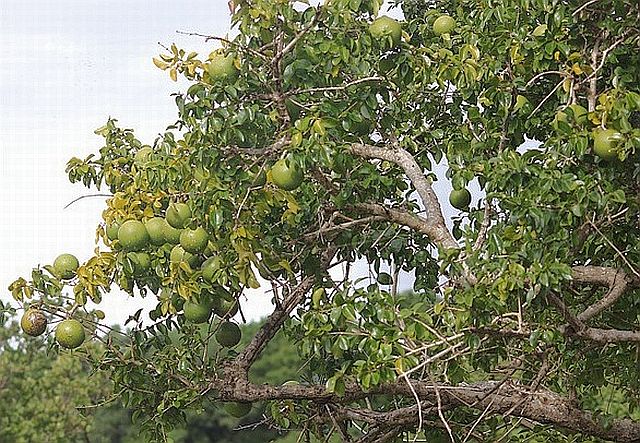 © Amoli
© Amoli
Cape Vidal, iSimangaliso, KwaZulu-Natal
Description
Small to medium sized, spiny deciduous tree or shrub with leaves turning yellow in autumn. Bark rough and flaking but not deeply fissured and corky. Branches often armed with curved or straight spines, not always clearly visible. The canopy is flattish and irregular and the tree is heavily branched. Leaves not clustered, opposite, elliptic, oblong to ovate, 3-7-veined from the base, variably hairy or hairless. Produces small greenish-white flowers in dense heads at the ends of branches (Sep-Feb/Spring - summer). The fruit tend to appear only after good rains. The smooth, hard fruit are large and green, ripening to yellow. They take a long time to ripen. Inside are tightly packed seeds surrounded by a fleshy, edible covering.
Distribution
Tropical Africa, in South Africa from the Eastern Cape, to KwaZulu-Natal, Mozambique and inland to eSwatini, Zimbabwe, northern Botswana and northern Namibia.
Habitat
This tree can be found growing singly in well-drained soils. It is found in bushveld, riverine fringes, sand forest and coastal bush.
Links:
https://books.google.de/books?id=RpVJJH ... ga&f=false
Val Thomas, Rina Grant: Sappi Tree Spotting: Kwazulu-Natal and Eastern Cape
Order: Gentianales. Family: Loganiaceae
 © Amoli
© AmoliCape Vidal, iSimangaliso, KwaZulu-Natal
Description
Small to medium sized, spiny deciduous tree or shrub with leaves turning yellow in autumn. Bark rough and flaking but not deeply fissured and corky. Branches often armed with curved or straight spines, not always clearly visible. The canopy is flattish and irregular and the tree is heavily branched. Leaves not clustered, opposite, elliptic, oblong to ovate, 3-7-veined from the base, variably hairy or hairless. Produces small greenish-white flowers in dense heads at the ends of branches (Sep-Feb/Spring - summer). The fruit tend to appear only after good rains. The smooth, hard fruit are large and green, ripening to yellow. They take a long time to ripen. Inside are tightly packed seeds surrounded by a fleshy, edible covering.
Distribution
Tropical Africa, in South Africa from the Eastern Cape, to KwaZulu-Natal, Mozambique and inland to eSwatini, Zimbabwe, northern Botswana and northern Namibia.
Habitat
This tree can be found growing singly in well-drained soils. It is found in bushveld, riverine fringes, sand forest and coastal bush.
Links:
https://books.google.de/books?id=RpVJJH ... ga&f=false
Val Thomas, Rina Grant: Sappi Tree Spotting: Kwazulu-Natal and Eastern Cape
Re: Africa Wild Tree & Shrub Book - Order Gentianales
701. Natal Flame Bush Alberta magna (Breekhout)
Order: Gentianales. Family: Rubiaceae
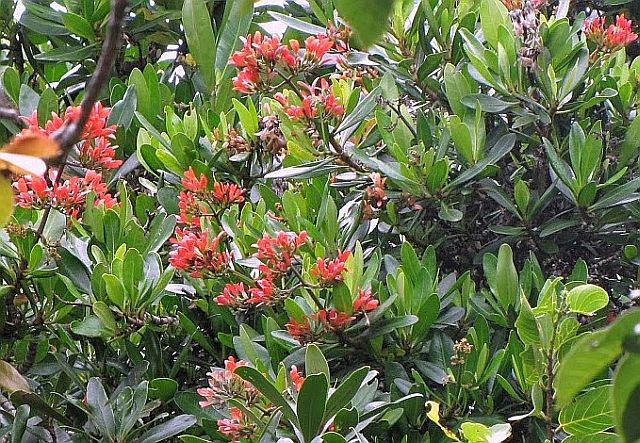 © Lisbeth
© Lisbeth
 © Lisbeth
© Lisbeth
KwaZulu-Natal, South Coast, Umtamvuna Nature Reserve
Description
At maturity Alberta magna has grey, rough bark on the stems, the branches are green or brown. The crown of shiny, evergreen foliage makes a foil for the large sprays of brilliant red, tubular flowers which form at the end of the branches in late summer/autumn (February-June). Individual flowers are about 2.5 cm long and are bright red with a hairy calyx. They are followed by small, ribbed fruit with large scarlet "wings" formed from the elongated calyx lobes. These remain colourful for a long time. Leaves are simple and oppositely arranged. They are 7.5-13 cm long and up to about 5 cm broad, oblong or oval. The leaf margins are untoothed and rolled inwards. The leaves are glossy dark green above and paler below, with a yellowish midrib. Lateral veins are sometimes conspicuous on the underside of the leaf.
Distribution
South Africa. Largely occurring in KwaZulu-Natal but extending into the Eastern Cape.
Habitat: Alberta magna grows very well at the coast to altitudes of 1 800 m. This species is found on the margins of small remnants of evergreen forest and on rocky sandstone outcrops, often near rivers and streams.
Links: Kristo Pienaar: The South African what Flower is That?
Order: Gentianales. Family: Rubiaceae
 © Lisbeth
© Lisbeth © Lisbeth
© LisbethKwaZulu-Natal, South Coast, Umtamvuna Nature Reserve
Description
At maturity Alberta magna has grey, rough bark on the stems, the branches are green or brown. The crown of shiny, evergreen foliage makes a foil for the large sprays of brilliant red, tubular flowers which form at the end of the branches in late summer/autumn (February-June). Individual flowers are about 2.5 cm long and are bright red with a hairy calyx. They are followed by small, ribbed fruit with large scarlet "wings" formed from the elongated calyx lobes. These remain colourful for a long time. Leaves are simple and oppositely arranged. They are 7.5-13 cm long and up to about 5 cm broad, oblong or oval. The leaf margins are untoothed and rolled inwards. The leaves are glossy dark green above and paler below, with a yellowish midrib. Lateral veins are sometimes conspicuous on the underside of the leaf.
Distribution
South Africa. Largely occurring in KwaZulu-Natal but extending into the Eastern Cape.
Habitat: Alberta magna grows very well at the coast to altitudes of 1 800 m. This species is found on the margins of small remnants of evergreen forest and on rocky sandstone outcrops, often near rivers and streams.
Links: Kristo Pienaar: The South African what Flower is That?
- Flutterby
- Posts: 43942
- Joined: Sat May 19, 2012 12:28 pm
- Country: South Africa
- Location: Gauteng, South Africa
- Contact:
Re: Africa Wild Tree & Shrub Book - Order Gentianales
691. Bushveld Gardenia, Transvaal Gardenia Gardenia volkensii (Transvaalkatjiepiering, Bosveldkatjiepiering)
Order: Gentianales. Family: Rubiaceae

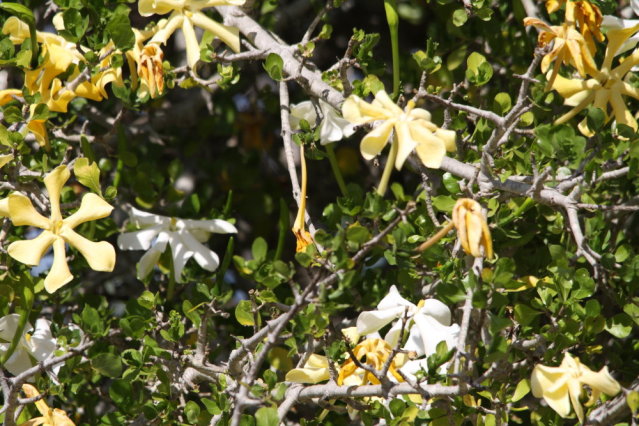
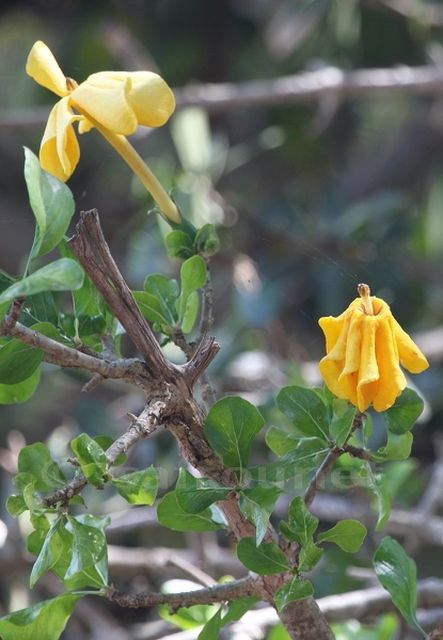 © nan
© nan
Kruger National Park, S119
Description
Small, multi-stemmed tree with a dense, rounded crown, 3–8 m high with arching branches, sometimes touching the ground. The bark is pale grey and smooth and the branchlets appear knobbly due to persistent leaf-like appendages at the base of the leaf stalk (stipules). The glossy, green leaves are usually in groups of three and crowded at the end of short branches. The flowers are solitary, large (up to 100 mm in diameter), and showy with a sweet scent. The trumpet-like flowers are white turning yellow with age, with a long tube that opens up into 6–9 lobes. The flowers open during the night and are probably moth-pollinated.
Habitat
Open woodland, bushveld and thicket.
Distribution
It occurs from tropical Africa through Namibia, Botswana, and the north-eastern parts of South Africa into KwaZulu-Natal in the south-east.
Links: Ernst Schmidt, Mervyn Lotter, Warren McClelandTrees and Shrubs of Mpumalanga and Kruger National Park
Order: Gentianales. Family: Rubiaceae


 © nan
© nanKruger National Park, S119
Description
Small, multi-stemmed tree with a dense, rounded crown, 3–8 m high with arching branches, sometimes touching the ground. The bark is pale grey and smooth and the branchlets appear knobbly due to persistent leaf-like appendages at the base of the leaf stalk (stipules). The glossy, green leaves are usually in groups of three and crowded at the end of short branches. The flowers are solitary, large (up to 100 mm in diameter), and showy with a sweet scent. The trumpet-like flowers are white turning yellow with age, with a long tube that opens up into 6–9 lobes. The flowers open during the night and are probably moth-pollinated.
Habitat
Open woodland, bushveld and thicket.
Distribution
It occurs from tropical Africa through Namibia, Botswana, and the north-eastern parts of South Africa into KwaZulu-Natal in the south-east.
Links: Ernst Schmidt, Mervyn Lotter, Warren McClelandTrees and Shrubs of Mpumalanga and Kruger National Park
Re: Africa Wild Tree & Shrub Book - Order Gentianales
694.1. Sand Rothmannia Rothmannia fischeri moramballae
Order: Gentianales. Family: Rubiaceae


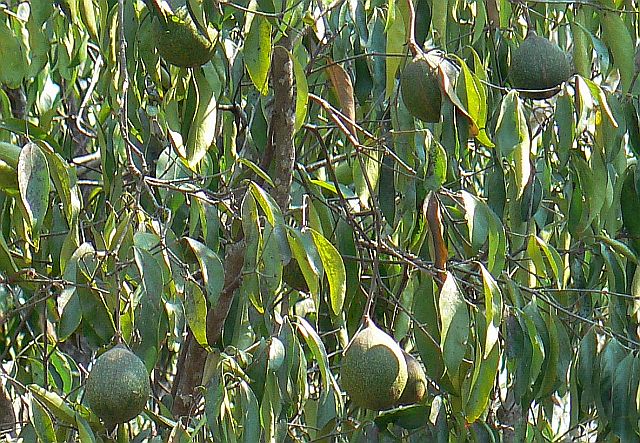
Tembe Elephant Park, KwaZulu-Natal
Description
Shrub or small tree. Bark grey-brown, smooth and peeling, revealing patches of the rusty underlayer. Leaves opposite, narrowly to broadly elliptic to obovate, somewhat leathery, shiny dark green above, paler below, hairless except for hairtuft domatia in the axils of the lateral veins and the midrib. Flowers bell-shaped and showy, solitary, up to 8 cm in diameter, cream with purple-pink markings in the corolla throat. Fruit spherical, hard, 3-6 cm in diameter, green with pale spots, turning blackish when ripe.
Subsp. moramballae is distinguished by the narrower leaves, slightly larger flowers and larger, more pyriform fruits. It generally occurs at lower altitudes.
Distribution
KwaZulu-Natal, Mozambique.
Habitat
Found in coastal and sand forest in Maputaland.
Order: Gentianales. Family: Rubiaceae



Tembe Elephant Park, KwaZulu-Natal
Description
Shrub or small tree. Bark grey-brown, smooth and peeling, revealing patches of the rusty underlayer. Leaves opposite, narrowly to broadly elliptic to obovate, somewhat leathery, shiny dark green above, paler below, hairless except for hairtuft domatia in the axils of the lateral veins and the midrib. Flowers bell-shaped and showy, solitary, up to 8 cm in diameter, cream with purple-pink markings in the corolla throat. Fruit spherical, hard, 3-6 cm in diameter, green with pale spots, turning blackish when ripe.
Subsp. moramballae is distinguished by the narrower leaves, slightly larger flowers and larger, more pyriform fruits. It generally occurs at lower altitudes.
Distribution
KwaZulu-Natal, Mozambique.
Habitat
Found in coastal and sand forest in Maputaland.
Re: Africa Wild Tree & Shrub Book - Order Gentianales
700.2 Jasmine-Gardenia, Small False Gardenia Heinsia crinita parviflora
Order: Gentianales. Family: Rubiaceae
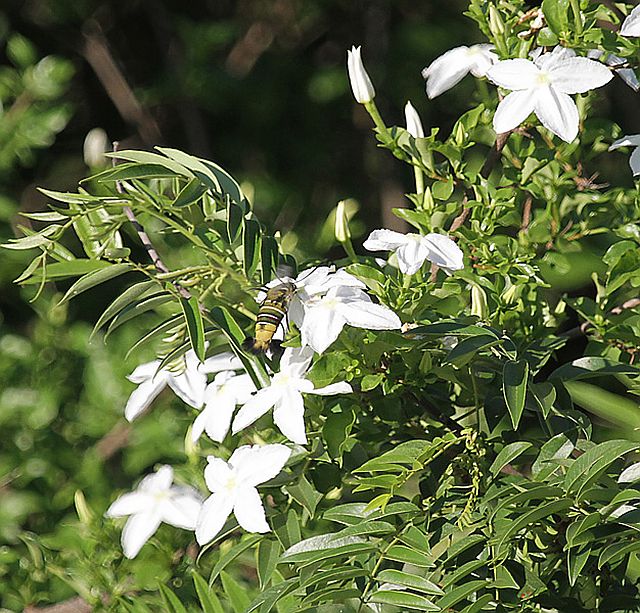 © leachy
© leachy
Kruger National Park, Mahonie Loop S99
Description
Small shrub or rarely almost a tree, 1–4.5 m tall. Leaves opposite, elliptic to ovate, deep green above, paler green below. Leaf blades mostly small, usually well under 6 × 2.5 cm, the tertiary venation not very evident beneath. White flowers from November to February. Calyx lobes mostly quite small, 3.5–6.5 × 0.8–2.5 mm, the claw part widened at the base. Fruits mostly smaller, 0.8–1.2 cm long, round to oval.
Habitat
Brachystegia and other deciduous woodland on sand, thicket and bushland, termite mounds, sometimes in rocky plains and old cultivation; 0–1110 m.
Distribution
From Somalia and Kenya to South Africa (Limpopo Province).
Links: Ernst Schmidt, Mervyn Lotter, Warren McCleland: Trees and Shrubs of Mpumalanga and Kruger National Park
Order: Gentianales. Family: Rubiaceae
 © leachy
© leachyKruger National Park, Mahonie Loop S99
Description
Small shrub or rarely almost a tree, 1–4.5 m tall. Leaves opposite, elliptic to ovate, deep green above, paler green below. Leaf blades mostly small, usually well under 6 × 2.5 cm, the tertiary venation not very evident beneath. White flowers from November to February. Calyx lobes mostly quite small, 3.5–6.5 × 0.8–2.5 mm, the claw part widened at the base. Fruits mostly smaller, 0.8–1.2 cm long, round to oval.
Habitat
Brachystegia and other deciduous woodland on sand, thicket and bushland, termite mounds, sometimes in rocky plains and old cultivation; 0–1110 m.
Distribution
From Somalia and Kenya to South Africa (Limpopo Province).
Links: Ernst Schmidt, Mervyn Lotter, Warren McCleland: Trees and Shrubs of Mpumalanga and Kruger National Park
Re: Africa Wild Tree & Shrub Book - Order Gentianales
694. Woodland Rothmannia Rothmannia fischeri fischeri (Bosveldvalskatjiepiering)
Order: Gentianales. Family: Rubiaceae
 © Kesheshe
© Kesheshe
Kruger National Park
Description
Shrub or small tree. Bark grey-brown, smooth and peeling, revealing patches of the rusty underlayer. Leaves opposite, narrowly to broadly elliptic to obovate, somewhat leathery, shiny dark green above, paler below, hairless except for hairtuft domatia in the axils of the lateral veins and the midrib. Flowers bell-shaped and showy, solitary, up to 8 cm in diameter, cream with purple-pink markings in the corolla throat. Fruit spherical, hard, 3-6 cm in diameter, green with pale spots, turning blackish when ripe.
Distribution
South Africa (KwaZulu-Natal, Limpopo), Zimbabwe and northwards to DRC.
Habitat
In semi-deciduous woodland, on rocky hillsides and in evergreen forest.
Order: Gentianales. Family: Rubiaceae
 © Kesheshe
© KeshesheKruger National Park
Description
Shrub or small tree. Bark grey-brown, smooth and peeling, revealing patches of the rusty underlayer. Leaves opposite, narrowly to broadly elliptic to obovate, somewhat leathery, shiny dark green above, paler below, hairless except for hairtuft domatia in the axils of the lateral veins and the midrib. Flowers bell-shaped and showy, solitary, up to 8 cm in diameter, cream with purple-pink markings in the corolla throat. Fruit spherical, hard, 3-6 cm in diameter, green with pale spots, turning blackish when ripe.
Distribution
South Africa (KwaZulu-Natal, Limpopo), Zimbabwe and northwards to DRC.
Habitat
In semi-deciduous woodland, on rocky hillsides and in evergreen forest.


